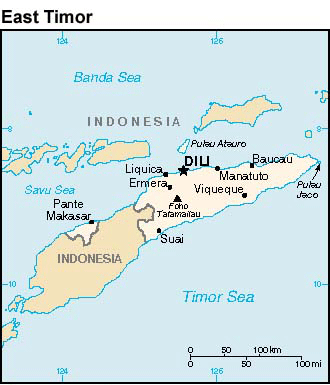The Definition of Libel:
 In East Timor, the government is examining whether defamation should be made a crime (Map from the U.S. Secretary of State, Bureau of East Asian and Pacific Affairs).
In East Timor, the government is examining whether defamation should be made a crime (Map from the U.S. Secretary of State, Bureau of East Asian and Pacific Affairs).
According to Black's Law Dictionary, libel is "A defamatory statement expressed in a fixed medium, esp. writing but also a picture, sign, or electronic broadcast."
Libel fits under the general umbrella of defamation. "Libel" is to "defamation" what "Passat" is to "Volkswagen." A Passat is always a Volkswagen, but there are Volkswagens that aren't Passats. Slander is another kind of defamation that is spoken (instead of being published through a fixed medium), and is often considered to be less serious. Where it gets confusing is in broadcast situations, where the line demarcating libel and slander is a dotted one. Often but not always, broadcast defamation falls into the slander camp, while the Internet defamation falls into the libel camp.
Back in the day, when kings and queens could become easily offended when their government was criticized, defamation was considered a crime. Thankfully, it is now just a tort. For more information about the dimensions of libel, check out the Media Law Resource Center definition.
Burden of Proof:
According to The Law of Public Communication, a plaintiff needs to prove six things to satisfy a jury:
1. The plaintiff must prove he or she was defamed.
2. The plaintiff has to be identified.
3. The defamation must be published (and this can mean only mentioning it to a third person).
4. It must be reckless or negligent -- or be produced with "actual malice." This concept came out of the New York Times v. Sullivan and the Gertz v. Robert Welch, Inc. cases I describe in my case law page. Actual malice was defined in the Gertz case when the Supreme Court noted the actions of an Ohio newspaper.
According to the Court:
-- The paper relied on a questionable source.
-- It did not seek out other, more reliable sources.
-- It ignored taped evidence to the contrary.
-- It ignored Connaughton's statements to the contrary.
-- It ignored the probability of questionable facts.
-- It published an editorial that seemed to indicate prejudice, as it contained opinions that were harbingers of conclusions reached in the news article.
-- The newspaper's management and its reporters gave differing accounts of assignments concerning the story.
5. Back to the burden of proof questions, if the speech in question involves "matters of public concern" (a notoriously amorphous concept), the speech in question must be false. Otherwise, a plaintiff does not necessarily have to prove falsehood if the other five burdens are met.
6. It must cause harm.
For views of libel, click on my cases page, defense page, news page, or page describing false light.






